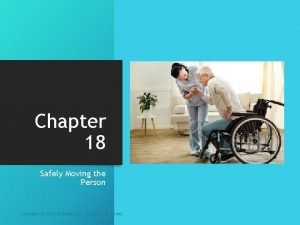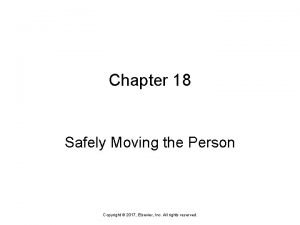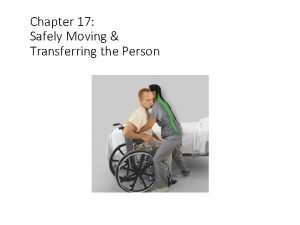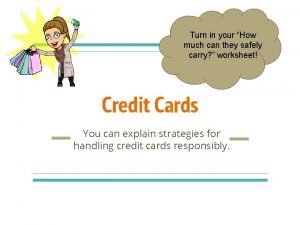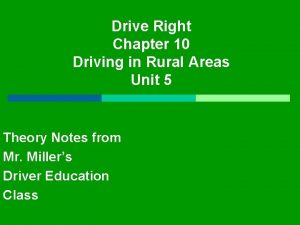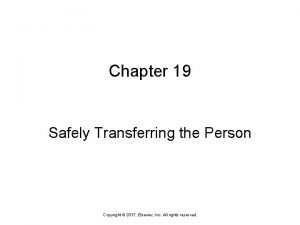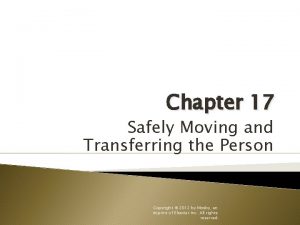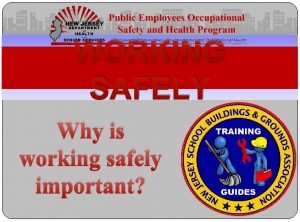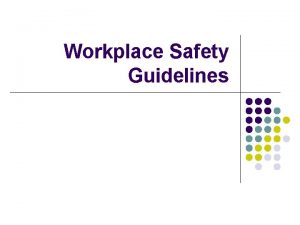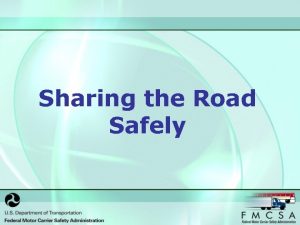Chapter 18 Safely Moving the Person Copyright 2017














- Slides: 14

Chapter 18 Safely Moving the Person Copyright © 2017, Elsevier, Inc. All rights reserved.

Safely Moving Persons • During these and other tasks, you must use your body correctly. • Turning and repositioning persons • Moving persons in bed Copyright © 2017, Elsevier, Inc. All rights reserved. 2

Preventing Work. Related Injuries • You must prevent work-related injuries when moving patients and residents. • The Occupational Safety and Health Administration (OSHA) recommends: • Minimizing manual lifting in all cases • Eliminating manual lifting when possible Copyright © 2017, Elsevier, Inc. All rights reserved. 3

Preventing Work. Related Injuries (Cont. ) • To safely move the person, the nurse and health team determine: • The person’s dependence level • The amount of assistance needed • What procedure to use • The equipment needed Copyright © 2017, Elsevier, Inc. All rights reserved. 4

Moving Persons in Bed 5 • Those who are weak, unconscious, paralyzed, or in casts need help moving in bed. • Code 4: Total Dependence—mechanical lift or friction-reducing device and at least two staff members • Code 3: Extensive Assistance—mechanical lift or friction-reducing device and at least two staff members • The person weighs less than 200 pounds—two to three staff members and a friction-reducing device • The person weighs more than 200 pounds—at least three staff members and a friction-reducing device Copyright © 2017, Elsevier, Inc. All rights reserved.

Moving Persons in Bed (Cont. ) • Protecting the skin • Protect the person’s skin during moving and transfer procedures. • Friction is the rubbing of one surface against another. • Shearing is when the skin sticks to a surface while muscles slide in the direction the body is moving. • Reduce friction and shearing when moving the person in bed by: • Rolling the person • Using friction-reducing devices Copyright © 2017, Elsevier, Inc. All rights reserved. 6

Moving Persons in Bed (Cont. ) • Raising the person’s head and shoulders • You can raise the person’s head and shoulders easily and safely by locking arms with the person. • Do not pull on the person’s arm or shoulder. • It is best to have help with older persons and with those who are heavy or hard to move. 7

Moving Persons in Bed (Cont. ) Moving the person up in bed • The person is moved up in bed for good alignment and comfort. • You can sometimes move lightweight adults up in bed alone if they can assist using a trapeze. • It is best to have help and to use an assist device. • Two or more staff members are needed to move heavy, weak, and very old persons up in bed. • Always protect the person and yourself from injury. 8

Moving Persons in Bed (Cont. ) • Moving the person up in bed with an assist device • The person is moved more evenly. • Shearing and friction are reduced. • At least two staff members are needed. • This procedure is used for: • Most patients and residents • Persons recovering from spinal cord surgery or spinal cord injuries • Older persons 9

Moving Persons in Bed (Cont. ) • Moving the person to the side of the bed • The person is moved to the side of the bed: • For repositioning and care procedures • Before turning • To limit the need to reach over the person • One method involves moving the person in segments. • With at least one co-worker, use a mechanical lift or an assist device: • Following guidelines • For older persons • For persons with arthritis • For persons recovering from spinal cord injuries or spinal cord surgery 10

Turning Persons • Persons are turned onto their sides: • To help prevent complications from bed rest • For certain procedures and care measures • The person is turned toward you or away from you. • The direction depends on the person’s condition and the situation. • After turning the person, position him or her in good alignment. • Use pillows to support the person in the side-lying position. 11

Turning Persons (Cont. ) 12 • Logrolling is turning the person as a unit, in alignment, with one motion. • The spine is kept straight. • The procedure is used to turn: • Older persons with arthritic spines or knees • Persons recovering from hip fractures • Persons with spinal cord injuries • Persons recovering from spinal surgery

Sitting on the Side of the Bed (Dangling) • Patients and residents sit on the side of the bed (dangle) for many reasons. • While dangling the legs, the person: • Coughs and deep breathes • Moves the legs back and forth in circles • Two staff members may be needed. • Persons with balance and coordination problems need support. • If dizziness or fainting occurs, lay the person down. 13

Re-Positioning in a Chair or Wheelchair • For good alignment and safety, the person’s back and buttocks must be against the back of the chair. • Follow the nurse’s directions and the care plan for the best way to re-position a person in a chair or wheelchair. • Do not pull the person from behind the chair or wheelchair. Copyright © 2017, Elsevier, Inc. All rights reserved. 14
 Chapter 18 safely moving the person
Chapter 18 safely moving the person Chapter 18 safely moving the person
Chapter 18 safely moving the person Chapter 19 moving the person
Chapter 19 moving the person When moving a person in segments, what do you move first?
When moving a person in segments, what do you move first? Höflichkeitsform 2. person plural
Höflichkeitsform 2. person plural First person in grammar
First person in grammar Person person = new person()
Person person = new person() First second and third person
First second and third person Chapter 19 medicines and drugs vocabulary practice answers
Chapter 19 medicines and drugs vocabulary practice answers Copyright secondary sara (2017) answers
Copyright secondary sara (2017) answers Understanding behaviour responding safely
Understanding behaviour responding safely How much can they safely carry
How much can they safely carry No job is so important that it cannot be performed safely
No job is so important that it cannot be performed safely Drive right chapter 10 answer key
Drive right chapter 10 answer key Chatting safely online
Chatting safely online
